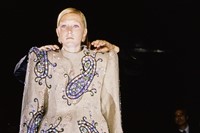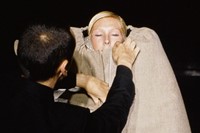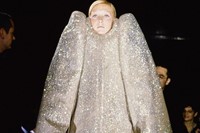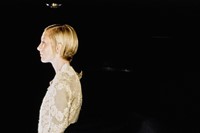The Dutch designers' A/W99 couture show paid tribute to the breakneck speed of fashion production by dressing model Maggie Rizer like a Russian matryoshka doll
Just five years after starting their label, a young Viktor Horsting and Rolf Snoeren were added to the couture calendar and, for their Autumn/Winter 1999 collection – their fourth couture show – the duo wowed a crowd with a nontraditional show both in terms of presentation and concept. While model Maggie Rizer stood on a turning platform, the two designers dressed her in layers of clothes from the collection until she began to resemble something more akin to a fashion sculpture than a human being. The show audience cheered as the hands of the designers dutifully applied each layer, the show itself a statement about the never-ending cycle of fashion and consumption. The designers refer to it as the Russian Doll collection, as it took inspiration from the form of matryoshka dolls. “The Maggie Rizer, Russian Doll show is very important,” Horsting says. “Transformation is always a very important word in our world, and we try to express transformation in different ways. That was one way of playing with that idea.” Indeed, André Leon Talley called the collection “the Viagra of couture week.”
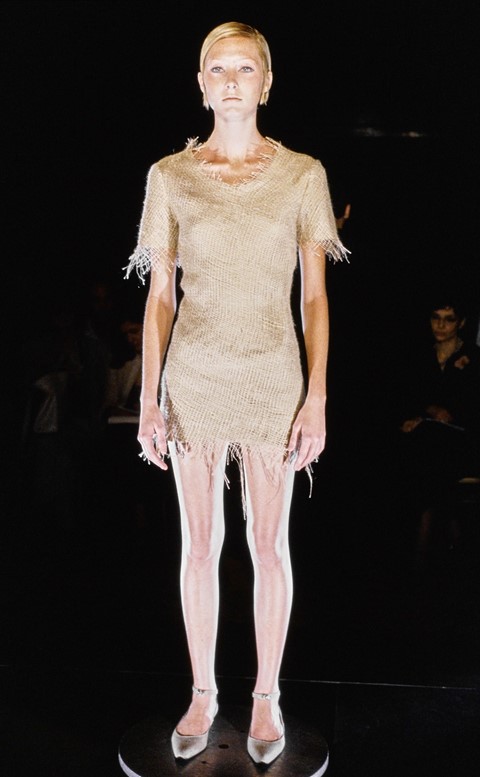
The Show
The historic show began with Rizer stood on the circular platform wearing a frayed minidress made of hessian sackcloth, her short blonde hair slicked back, her eyes pencilled with graphic liner, before Horsting and Snoeren came out and delicately placed a pair of flat shoes on her feet. The entire show lasted just over 15 minutes, and in that timespan, the designers added a total of ten new layers on top of the original barebones dress until she towered in a thick cocoon-like coat with shoulders that were as high as the top of her head. Each beautifully crafted piece – including shimmering dresses covered in metallic sequins, sweet printed dresses with neat bows and microruffles, and robes made of lace, diamante and crystals – read as a mixture of homespun and royal, resembling, in fact, the silhouettes of 15th-century Boyars. By the show’s end, Rizer wore so many garments she seemed barely able to move. Thus trapped in the cycle of fashion, the designers laid a large floral garland around her in a circle before exiting the stage. “There was a moment when we found the pace very difficult but we are catching up,” the designers once said of the breakneck speed of the industry. “The demands will not change so you just have to go with the flow.”
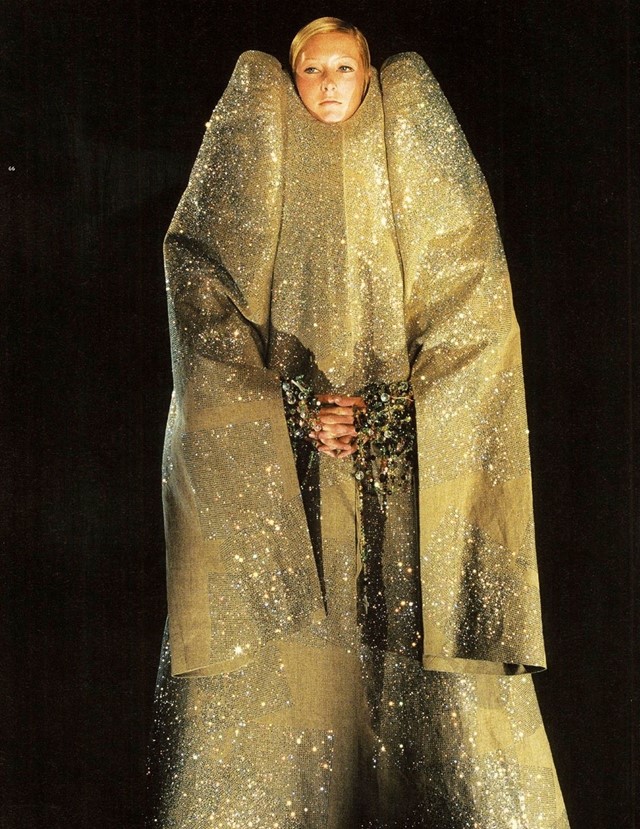
The People
Maggie Rizer's waif-like, china doll appearance made her a natural choice for such a show. As for the designers, the two dressed exclusively in black for its duration, the effect of which was to make their hands especially visible, bringing a literal understanding to the expression 'petites mains'. One by one, they brought out crystal-embellished dresses which zipped or buttoned from the bottom to the top, and placed them on Rizer before the audience. She never once buckled under the weight of the heavy layers of fabric, and aided the designers in the performance by sticking out her arms to help apply the vest-like dresses whenever possible. “We always work with what we feel at the moment,” said Horsting on the choice to create a powerful piece of art that addressed the speed of fashion. “Even if it’s a feeling that’s not nice, we always want to work with it.”

The Impact
“We would like it to be a laboratory,” Horsting told The Independent of his approach to couture. The designer duo would go on to present many more shows that pushed boundaries and took an intellectual approach to fashion, but the Russian Doll show was one of their last couture offerings before making a return in 2013. The Spring/Summer 2006 show was a literal upside-down and backwards fashion show, and the duo have since gone on to resurrect their fashion fantasies in museums around the world. “We call ourselves fashion artists, and we think it can be both,” said Snoeren, referring to the idea of art and fashion blending. “I think fashion can be art, but it’s not necessarily always the case. Fashion can also purely be functional.” For the Russian Doll collection, the theme of consumerism as a fast and furious world which will swallow you whole given half a chance is one that Horsting and Snoeren reinterpreted again and again during their career.
For the label’s Autumn/Winter 2010 ready-to-wear show, the pair performed the Russian Doll concept in reverse, peeling layers of clothing from models like Kristen McMenamy on the runway. “We would like couture to have the same function it had in the 1950s. Then, couture was leading fashion. At the moment it's more about adding up everything that can be done with sequins and feathers,” they said.


